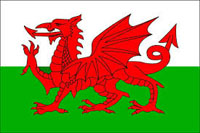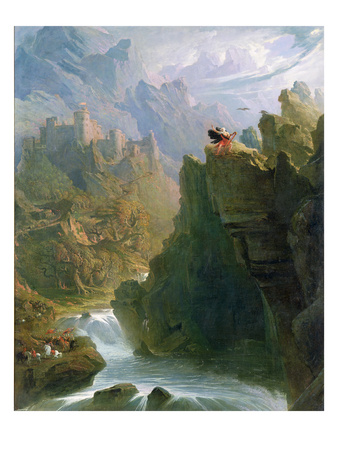Wales/Cymru
Wales/Cymru: ° Aberdyfi ° Aberystwyth ° Bangor (Gwynedd) ° Borth (Ceredigion) ° Cardiff, Pontypridd, Swansea (Glamorgan) ° Holyhead (Anglesey) ° Fishguard, Milford Haven, Pembroke (Pembrokshire) ° Porthmadog (Eifionydd) ° The Welsh Language ° The Mandans and Owain of Wales
Fishguard, Milford Haven, Pembrokeshire

This guide to Welsh Language Pronunciation has been borrowed with permission from www.Go4AWalk.com, a site in Wales featuring recommendations, accommodations, needed gear, photography, and more than 13,000 walks and walking ideas.
Vowels | Consonants | Dipthongs

While English is the most common language in Wales, Welsh is still used and actively promoted by some half a million people. It is particularly strong in the Western and Northern regions where the Welsh language remains strong and highly visible - such as on road signs.
For the walker planning to scale the hills and mountains of Wales, a cursory glance at the map will reveal that most mountain tops and geographical features are described in Welsh. At first sight, this seemingly incomprehensible language may be daunting, yet a little knowledge of the language and how to pronounce it correctly will enhance your experience in these majestic surroundings and in reading books about Wales, it's history and people.
The spelling is regular and phonetic, so that once you know the rules, you can learn to read it and pronounce it without too much difficulty.

Just remember that in Welsh ALL the letters are pronounced (even if sometimes its looks impossible).
See if you can read the following out loud. It is english but written using the sounds of the Welsh alphabet:
Ai hop ddat yw can ryd ddys and ddat yt meiks sens tw yw. Iff yw can ryd ddys, dden yw sawnd ryt and ar redi tw gow hycing in wals widd gofforawalc dot cwm. Gwd lwc and Haf ffyn.
Click here to see how it should have sounded.
The Welsh Alphabet:
There are 28 letters in the Welsh Alphabet comprising 7 Vowels and 21 Consonants and 13 dipthongs. The letters:
A | B | C | Ch | D | Dd | E | F | Ff | G | H | I | L | Ll |
M | N | Ng | O | P | R | Rh | S |T | Th | U | W | Y
The dipthongs are: Ae | Ai | Au | Aw | Ei | Eu | Ew | I'w | Y'w | Oe | Ow | Wy | Ywy
Officially, Welsh does not possess the letters J, K, Q, V, X or Z, though you will come across imported words from other languages using these letters where no suitable Welsh letter is available, notably Jones (!) and Wrexham (Wrecsam).
Vowels | Consonants | Dipthongs
Welsh vowels have distinctive sounds and it is the difference between these sounds that enables the listener to differentiate between and understand the meanings of, words. An example is the difference between mil = thousand and mul = donkey.
A as in man.
Welsh words: aber (abber); Garn (garn)
E as in bet or echo.
Welsh words: carnedd (caneth)
I as the ee in queen.
Welsh words: ni (nee); mi (mee); lili (leelee); min (meen)
O as in lot or hot.
Welsh words: o'r (oh/rr with a rolled r); don (dohn); pont (pohnt)
U as the 'i' in pita
Welsh words: canu (can-i); cu (key); Cymru (Kum-ri); tu (ti); un (in)
W as the 'oo' in Zoo.
Welsh words: cwm (koom); bwlch (boolch)
The first is 'uh' when used as the definite article
Welsh words: y ci (uh key) = the dog.
The second is similar to the Welsh u
Welsh words: Glyder (gleeder); byd (beed)
The third is similar to the English u in under.
Welsh words: Y (uh); Yr (ur); yn (un);
All the vowels can be lengthened by the addition of a circumflex (^).
Welsh words: T n (taan), l n (laan).
Since the circumflex (^) changes the sound of the word, it also changes the meaning.
Welsh words: Gl n (glaan) = Clean, Glan (glan) = Riverbank or Shore.
Vowels | Consonants | Dipthongs
B | C | Ch | D | Dd | F | Ff | G | H | L | Ll | M | N | Ng | P | R | Rh | S | T | Th
Usually(!) B, D, H, L, M, N, P, R, S, and T are pronounced the same as they are in English (Since all letters in Welsh are pronounced, H is never silent).
C always 'hard' as in cat:
Welsh words: cwm (coomb); carnedd (caneth); Cymru (Kumree)
Ch soft and aspirated as in the Scottish loch or Docherty:
Welsh words: fach (vach); uwch (youch ), chwi (Chee)
Dd as the 'th' in the or seethe:
Welsh words: bydd (beethe); carneddau (caneth-eye); ddofon (thovon); ffyddlon (futh lon)
F as the 'v' in five:
Welsh words: afon (avon); Tryfan (Try-van); fydd (veethe); hyfryd (huvrid); fawr (vowr), fach (vach)
Ff as the 'f' in fight:
Welsh words: ffynnon (funon); ffyrdd (furth); ffaith (fithe)
G always 'hard' as in goat:
Welsh words: ganu (ganee); ganaf (ganav); angau (angeye); gem (game)
Ng as the 'ng' in finger:
Welsh words Yng Nghaerdydd (ung hire deethe); Yng Nghymru (ung Humree)
Ll is peculiarly Welsh and difficult to describe. Form your lips and tongue to pronounce the letter L, but then blow air gently around the sides of the tongue instead of saying anything. The nearest you can get to this sound in English is an l with a th in front of it:
Welsh words: llan (thlan); llyn (thlin); llwyd (thlooid)
Rh sounds as if the h comes before the r with a slight blowing out of air before the r is pronounced:
Welsh words: rhengau (hrengye); rhag (hrag); rhy (hree)
Th as 'th' in think:
Welsh words: gwaith (gwithe); byth (beeth)
Vowels | Consonants | Dipthongs
Ae | Ai | Au | Aw | Ei | Eu | Ew | I'w | Y'w | Oe | Ow | Wy | Ywy
Ae, Ai and Au as the 'y' in my:
Welsh words: ninnau (nineye); mae (my); henaid (henide); main (mine); craig (crige)
Aw as the 'ow' in cow:
Welsh words: mawr (mour); prynhawn (prinhown); fawr (vow)
Eu and Ei as the 'ay' in pray:
Welsh words: deisiau (dayshy), or in some dialects (deeshuh); deil (dale or dile); teulu (taylee or tyelee)
Ew is more difficult to describe. The nearest English sound is probably the Birmingham pronunciation of 'you'.
Welsh words: mewn (meh-oon); tew (teh-oo)
I'w and Y'w as the 'ew' in yew:
Welsh words: clyw (clee-oo); byw (bee-you or b'you); menyw (menee-you or menyou)
Oe as the 'oy' in toy:
Welsh words: croeso (croyso); troed (troid); oen (oin)
Ow as the 'ow' in tow or low:
Welsh words: Rhown (rhone); rho (hrow)
Wy as the 'wi' in win or the french 'oui':
Welsh words: Wy (oo-ee); wyn (win); mwyn (mooin)
Ywy as the 'ui' in fluid:
Welsh words: bywyd (bowid);
That sentence:
Ai hop ddat yw can ryd ddys and ddat yt meiks sens tw yw. Iff yw can ryd ddys, dden yw sawnd ryt and ar redi tw gow hycing in wals widd gofforawalc dot cwm. Gwd lwc and Haf ffyn.
Should have sounded thus:
I hope that you can read this, and that it makes sense to you. If you can read this, then you sound right and are ready to go hiking in Wales with go4awalk.com. Good luck and have fun.
1899. World's Fleet. Boston Daily Globe
Lloyds Register of Shipping gives the entire fleet of the world as 28,180 steamers and sailing vessels, with a total tonnage of 27,673,628, of which 39 perent are British.
| Great Britain | 10,990 vessels, total tonnage of 10,792,714 |
| United States | 3,010 vessels, total tonnage of 2,405,887 |
| Norway | 2,528 vessels, tonnage of 1,604,230 |
| Germany | 1,676 vessels, with a tonnage of 2,453,334, in which are included her particularly large ships. |
| Sweden | 1,408 vessels with a tonnage of 643, 527 |
| Italy | 1,150 vessels |
| France | 1,182 vessels |
For Historical Comparison
Top 10 Maritime Nations Ranked by Value (2017)
| Country | # of Vessels | Gross Tonnage (m) |
Total Value (USDbn) |
|
|---|---|---|---|---|
| 1 | Greece | 4,453 | 206.47 | $88.0 |
| 2 | Japan | 4,317 | 150.26 | $79.8 |
| 3 | China | 4,938 | 159.71 | $71.7 |
| 4 | USA | 2,399 | 55.92 | $46.5 |
| 5 | Singapore | 2,662 | 64.03 | $41.7 |
| 6 | Norway | 1,668 | 39.68 | $41.1 |
| 7 | Germany | 2,923 | 81.17 | $30.3 |
| 8 | UK | 883 | 28.78 | $24.3 |
| 9 | Denmark | 1,040 | 36.17 | $23.4 |
| 10 | South Korea | 1,484 | 49.88 | $20.1 |
| Total | 26,767 | 87.21 | $466.9 | |











 Copyright ~ 1998-2018.
Copyright ~ 1998-2018. 